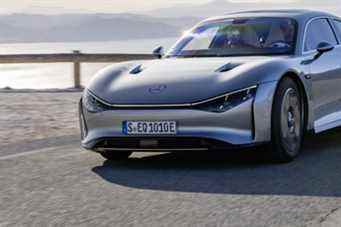We can boast ad nauseam the electric vehicle for its environmental virtues, the sinews of war to ensure its adoption remains its autonomy. While city dwellers are less affected by this problem, rural customers are much more sensitive to these additional kilometers made possible by technical advances. Mercedes-Benz is well aware of this and conducted a successful trial with an electric prototype, the Vision EQXX.
Posted at 11:45 a.m.
The engineers of the star brand were able to travel 1008 km on a full charge during a trip criss-crossing German, Swiss, Italian and French roads. To increase the level of difficulty of the feat, sections of German expressways were looped at an average speed of 140 km/h and the vehicle passed through the Swiss Alps and northern Italy and finished its way. on the Cote d’Azur, France. Admittedly, the temperature was far from that of our Quebec winters, varying from 3 to 18°C, and that obviously had an impact on the feat.
Very impressive element, the sedan, once arrived at its destination, still had 140 km of autonomy displayed on the meter on 15% of the battery charge. Mercedes-Benz estimates that it consumed 8.7 kWh/100 km, less than half of a modern electric SUV.

PHOTO PROVIDED BY MERCEDES-BENZ
The Vision EQXX took a variety of roads.
The secrets of its efficiency
Obviously, this degree of efficiency is not achieved in a snap of the fingers. The Vision EQXX can first be based on an extremely smooth dress that pierces the air with a drag coefficient of only 0.17. This greatly increases autonomy in a highway context.
Then there is the weight.
Despite using a 100kWh battery that is said to be among the most energy-dense in the industry today, the sedan weighs 1755kg, about 100kg more than the Chevrolet Bolt, a subcompact .
To ensure this featherweight for an electric car, Mercedes-Benz has used cutting-edge materials, including a composite of carbon fiber and sugar for the battery cover. A lot of aluminum is also used everywhere, especially to make up a huge part that makes up the rear part of the car.

PHOTO PROVIDED BY MERCEDES-BENZ
Mercedes-Benz used state-of-the-art materials, including carbon fiber composite.
The tires with a diameter of 20 inches, but a width of barely 185 mm, are also used to reduce resistance, as well as a solar panel composed of 117 photovoltaic cells which have increased the autonomy of 25 km during the trip.
Energetic efficiency
The 241 hp engine is not left out either. Mercedes-Benz estimates that it has an energy efficiency of 95%, much better than a heat engine which generally hardly exceeds 40%. It operates at 900 V, which provides extremely fast energy transfer.
Granted, the exercise might seem superfluous to some, but it heralds new technologies that will cascade onto production models in the not-too-distant future. A fascinating evolutionary story.

